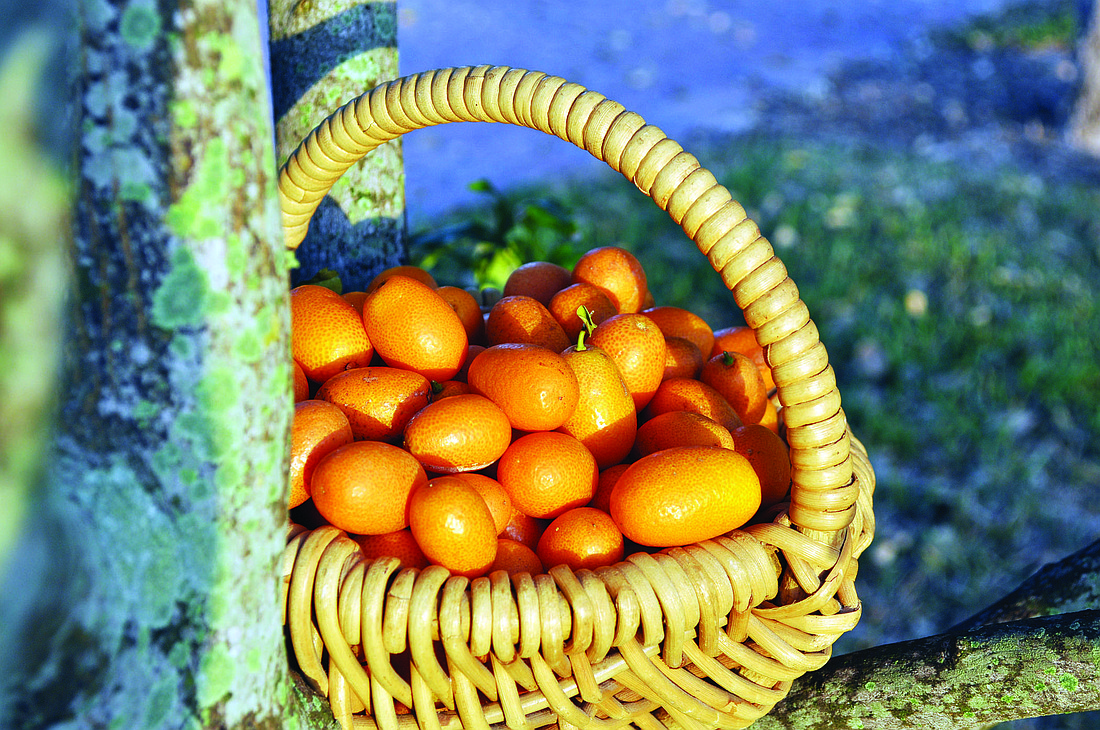- April 17, 2024
-
-
Loading

Loading

The first and most obvious surprise of the kumquat is its taste. It is the sweet tart of the citrus clan, and even more oddly, it is the skin, which is sweet, and the pulp that is tart. The next surprise is that even though it looks like a citrus, smells like a citrus and is certainly similar in taste, it is not technically a member of the citrus family. This native of China had a change of genus status in 1915, when it was discovered that the fruit’s cellular structure is significantly different from other citrus. It was then assigned its own genus name, Fortunella, in honor of Robert Fortunel, who introduced kumquats in 1846 to Europe. The name comes from Cantonese, meaning “golden orange” and was first spelled kam kwat.
This is the end of the kumquat season in Florida and its peak in California. That means that the owners of any kumquat trees in your neighborhood will be more than happy to have you pick the remaining fruit. The trees in these parts are remarkably generous, leading their owners to behave similarly. Always ask, of course. If you don’t have that kind of access, you can often find them in the supermarket, though they can be pricey.
The easiest way to enjoy a kumquat is simply to wash it and eat it in a bite or two. Be prepared: The first sensation can be almost sour. But the tang quickly cedes to sweetness — a rewarding transition that is yet another delightful surprise.
When you have had your fill of the raw fruit (which can be habit-forming), you will want to keep some on hand, which is as easy as cooking them in a simple sugar syrup. Unless you are making a huge batch, there is no need to go through a sterilizing routine. Simply cleanse jars and lids with boiling water, ladle the fruit in hot and keep in the refrigerator. You will be surprised how many times you take them out to enjoy as a versatile, sweet relish with anything from a chicken-salad sandwich to your favorite dinner entrée. Come holiday time, combine your candied kumquats with your favorite cranberry sauce. Or make the combination fresh, using the following recipe. There are literally dozens of other ways to use this little treasure, including a delicious cake made famous by the late Sylvia Collins, of Longboat Key. Request that recipe via email to [email protected], and if you have a favorite to share, please send it along.
CRANBERRY-KUMQUAT COMPOTE
Adapted from Gourmet Magazine, circa 1997
Yield: about 3 1/2 cups
1/2 to 1 pound kumquats (10 to 20)
12 ounces fresh
cranberries
1 cup sugar
1 cup water
Thinly slice kumquats crosswise and remove seeds. Pick over cranberries. Combine sugar and water in a small saucepan, and stir until sugar is dissolved, about five minutes. Add kumquats and simmer five minutes. Remove kumquats to a bowl using a slotted spoon. Add cranberries to the syrup and simmer 10 minutes or until they are all popped. Cool completely, then chill. If making ahead, refrigerate fruit in separate containers, so kumquats will retain their color. Just before serving, stir kumquats into cranberry mixture.
PRESERVED KUMQUATS
Yield: about two pints
2 pounds kumquats
2 cups sugar
2 cups water
Wash the kumquats and cut in half lengthwise. Use the tip of a paring knife to remove as many seeds as you can find, and don’t worry if you miss some.
Combine sugar and water in a large saucepan over medium-high heat, and cook until sugar is dissolved, using a pastry brush to return any sugar that clings to the sides of the pan to the syrup. Add kumquats and simmer five minutes. Ladle into jars that have been rinsed with boiling water and store in the refrigerator almost indefinitely.
Contact Molly Schechter at [email protected]